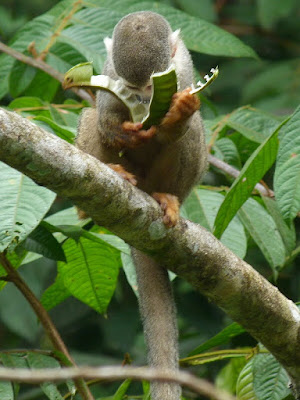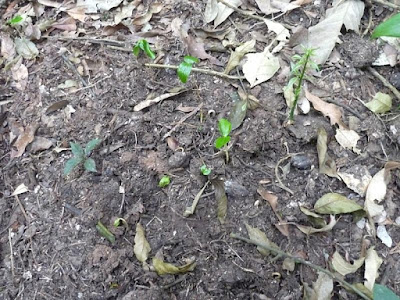I was reading an intriguing story yesterday - which I'll get to shortly - which led me to think about animals being 'employed' by plants to distribute seeds. There are various ways of doing this, including by sticky burrs which cling to fur and feathers, eventually being dropped (or releasing the seed) some distance from the start of the journey.
Australia has perhaps the richest ant fauna in the world, so it is unsurprising that plants from a wide range of Australian families have employed them to assist in distributing seeds. Obviously they don't want the ants to break the seeds up and eat them, and in fact the seeds are usually too hard for the ants to eat. Instead the plant attaches a nutritious temptation to the seed, which the ants haul off to the nest, detaching the seed when they get there and leaving it on the surface or in an underground garbage dump. This dry attachment is either an aril (if it derives from the seed attachment) or an elaiosome (a fatty body different from the aril), and is smaller than the seed. Ants have been observed carrying such seeds up to 75 metres from where they found them.
 |
| Discarded seeds surrounding an ant nest, near Alice Springs, central Australia. |
But does it work? It certainly does!
 |
| Seedlings sprouting from ant nest, Great Sandy Desert, Western Australia. |
Ants don't seem to pay much attention to colour, so these arils and elaiosomes tend to be pale in colour. However some acacias have colourful (especially red) arils, which are displayed high on the plant for birds to gather - again taking the seeds along with it.
 |
| Blackwood Wattle Acacia melanoxylon, pods, Namadgi NP, near Canberra. |
Overall however the simplest and most effective strategy is to have the seeds eaten by a large mobile animal and discarded elsewhere, in droppings or perhaps as regurgitate. Energy is a very important resource - and temptation - for animals, which of course is why so many plants wrap their seeds in colourful, sugar-filled fruits, constructed from the wall of the fertilised ovary. The hard seed passes through the body, deposited sometimes many kilometres away. Here are some birds caught in the act!
 |
| Double-eyed Fig Parrot Cyclopsitta diophthalma eating figs (of course), Cairns Esplanade, Queensland. |
 |
| Metallic Starlings Aplonis metallica eating palm fruit, Cairns Botanic Gardens, Queensland. |
 |
| Silvereye Zosterops lateralis, with heath berries, Family Ericaceae (or Epacridaceae), Australian National Botanic Gardens, Canberra. |
In rainforests in particular, birds and fruit bats are very important vectors of the whole forests' seeds - trees, lianas and shrubs.
Another important contributor is Australia's second-largest bird.
 |
| Southern Cassowary Casuarius casuarius, Atherton Tableland, northern Queensland. |
We now know that the seeds of the Javan Ash Ryparosa kurrangii, a rainforest tree from north Queensland, germinate far better if they've passed through a cassowary. In fact, over 90% of seeds taken from cassowary droppings germinated, compared with only 4% of uneaten seeds. It has long been known that cassowaries are important vectors of rainforest seeds, but this adds another dimension to their value in the rainforest ecosystem. (The researchers also incidentally found that Javan Ash seeds have one of the highest levels of cyanogens ever recorded in a plant, but presumably the birds pass them through quickly enough and without breaking the surface of the seed, so that they are unaffected.)
In rainforests elsewhere in the world, other birds perform similar roles.
 |
| Yellow-throated (or Black-mandibled) Toucan Ramphastos ambiguus, with cecropia fruit, Wild Sumaco Lodge, northern Ecuador. |
 |
| Grass-green Tanager Chlorornis riefferii, Abra Patricia Lodge, northern Peru. |
 |
| Red-crowned Barbet Psilopogon rafflesii, Bako NP, Sarawak. |
Bats must never be underestimated however, despite doing their valuable work under cover of darkness.
They are not the only mammals to perform the task however.
 |
| Ecuadorian Squirrel Monkey Saimiri macrodon (or Saimiri sciureus macrodon), Yasuní NP, Ecuador. |
 |
| Seedlings sprouting from elephant dropping, Kibale NP, Uganda. |
Some plants have even secondarily 'invented' fruit by causing the stem immediately below the bare terminal seed to swell, turn red or black, and fill with sugars, for the same reason as other plants develop 'real' fruit.
 |
| Dwarf Ballart Exocarpos strictus.The red 'fruit' is the pedicel, or flower stem, the real fruit is the hard dark nut below it, comprising a seed in a hard casing. |
Which is pretty much the story - except that I mentioned at the start something I read which triggered this. It was a study conducted by Japanese ecologists which implied that at least one group of animals might have adopted a similar strategy to distribute their 'seeds' - which are really eggs. Stick insects, or phasmids, are poor distributors - many are flightless - but occur on many islands.
 |
| Titan Stick Insect Acrophylla titan, Nowra, south coast NSW. This one can grow to 25cm long. |
Moreover, many species can reproduce parthogenetically - ie without mating. In this case all the hatchlings are female; if they mate both males and females result. The scientists presumably wondered about these two things, because they tried feeding eggs of three phasmid species to Brown-eared Bulbuls Hypsipetes amaurotis, a major phasmid predator in Japan. Up to 20% of the eggs survived, and some hatched, meaning that the birds could potentially be enabling the flightless insects to island-hop. Their next task is to compare the genetics of stick insects along known bird flight paths, to see if there is a correlation. A small thing, but surely much of life depends on a collation of small interesting things...
 |
| White-bellied Cuckooshrike Coracina papuensis with large (probably gravid female) phasmid, Nowra. Did this bird do a favour to its lunch by sparing and spreading its eggs? |
NEXT POSTING THURSDAY 14 JUNE
(And
remember that you can get a reminder when the next post appears by
putting your email address in the Follow by Email box in the top right
of this screen.
And I'd love to receive your comments - it's easy and you don't need to sign in!)
And I'd love to receive your comments - it's easy and you don't need to sign in!)




























































